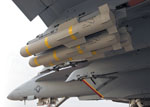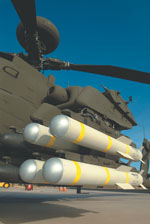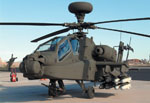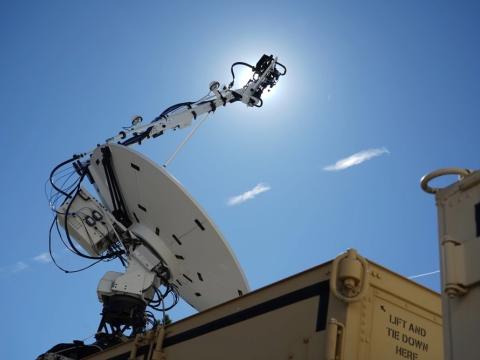Multipurpose Missile Program Accelerates
 |
The Joint Air-to-Ground Missile (JAGM) is an effort managed by the U.S. Army, Navy and Marine Corps to develop a multipurpose missile that can operate on a variety of fixed- and rotary-wing platforms. JAGM’s software allows the missile to interface automatically with an aircraft’s targeting system once it is attached to a launch rail. |
A new missile soon will allow different
The Joint Air-to-Ground Missile (JAGM) program is a tri-service effort managed by the U.S. Army, Navy and Marine Corps. It is designed to replace current missiles such as the GM-114 Hellfire, AGM-65 Maverick and GM-71 TOW with a single missile. JAGM is being designed for use by fixed-wing, rotary-winged and unmanned aircraft. Key features of the new missile are a tri-mode seeker, a multipurpose warhead and an extended range rocket motor.
According to JAGM program manager Lt. Col. Robert Barrie, USA,
JAGM originated from another program, the Joint Common Missile (JCM), which sought to develop an advanced multipurpose air-to-ground missile capable of working on a variety of aircraft. The JCM program was canceled in 2007, but the Army revived its key goals and technical aspects as part of JAGM.
The JAGM program began in late 2008 with the award of two fixed-price incentive contracts to two teams led by Lockheed Martin Corporation and Raytheon Company/the Boeing Company. The first part of the contract is a 27-month development period that includes a preliminary design review, an initial platform integration and a test firing of three prototype missiles from each team. This technology development phase of the contract ends in the first quarter of fiscal year 2011. The program’s first milestone also takes place in the first quarter of 2011. Col. Barrie says that the program’s goal is to achieve an initial operational capability in 2016.
A key feature of the missile is its software, which will allow it to be loaded onto a variety of platforms and immediately interface with their targeting systems. JAGM is being designed to operate on the Army’s AH-64D Apache attack helicopters, ARH-70 Arapaho scout helicopters and MQ-1C Sky Warrior unmanned aerial vehicles (UAVs); Marine Corps AH-1Z Super Cobra attack helicopters; and Navy MH-60R/S Seahawk helicopters and F/A-18E/F Super Hornet jet fighters. Col. Barrie describes this as a game-changing capability because it creates great operational flexibility and shortens logistics tails. He adds that there are currently some 15 different Hellfire variants in use.
The colonel states that JAGM must be at least as good as the missiles it replaces. But he notes that the program’s main focus is for the missile to operate on obscured battlefields, to provide increased combat range and to work with a variety of aircraft. JAGM will have double the range of the Hellfire and have significant range increases over the Maverick and air-launched TOW missiles. “We are at least as good as, and in most cases significantly better than, those weapons systems,” Col. Barrie says.
“JAGM is not a missile program. It’s a system solution program,” says Michael Riley, Raytheon’s JAGM business development manager,
The missile’s integration software allows the weapon to be removed from its crate and mounted immediately on a jet or helicopter. JAGM’s software communicates with the aircraft’s targeting system to determine the best sensor to use for the mission. Steven Sherrick, Boeing’s JAGM business development manager,
Sherrick admits that every airborne platform has a different targeting system that must interface with the missile. These systems include the millimeter-wave sensor on the Apache Longbow and the AN/APG-79 active electronically scanned array (AESA) radar and forward-looking infrared sensor on the F/A-18E/F.
Boeing has the added advantage of integrating the missiles onto its own aircraft, Sherrick says. He notes that Boeing already has modified a Hellfire variant for the
As with its competitors, the Lockheed Martin team also cites deep platform design experience. Hady Mourad, Lockheed Martin’s JAGM program director, notes that his firm was a competitor in the original JCM program. Using its JCM work as a technology baseline, the company also has developed several technical improvements that it is applying to its JAGM offering. Key among these advances are improvements to its tri-mode seeker design. Mourad notes that Lockheed Martin’s seeker design is in its fourth generation with more than 5,400 hours of successful testing already completed.
 |
 |
Drawing on technology from previous programs and combat-proven systems, JAGM will replace a variety of air-to-ground weapons such as these Hellfire missiles. JAGM features increased range and a multimode sensor that allows the weapon to autonomously track moving and stationary targets. |
Lockheed Martin also is relying on existing, combat-proven technology for its missile. Mourad notes that his firm developed and manufactured the baseline technology for all of the sensor modes in JAGM—the Hellfire II, Javelin and AGM-114 Longbow Hellfire. He relates that Lockheed Martin combined these three sensors in its version of the JCM. The firm’s multipurpose warhead is based on the warhead it designed for the Hellfire II.
The sensor, rocket motor and warhead are also the three highest-risk parts of the program. Riley maintains that the Raytheon/Boeing team also is reusing systems and technologies already in service or in design in other programs. “We have been able to reduce the overall risk [to] this program, at the same time lowering costs, reducing the maintenance burden and improving the reliability of our JAGM solution before we’ve even fired the first round,” he declares.
The tri-mode seeker is the heart of JAGM. Riley offers that no multimode seeker weapons are currently in the field. The majority of the air-to-ground weapons used by the
To counter this atmospheric limitation, in 1997 the U.S. Army developed the AGM-114 Longbow Hellfire, a millimeter wave guided version of the missile. A Cold War weapon, millimeter wave guided missiles were believed to be the best solution to attack massed Soviet armor formations. The missile is a fire-and-forget weapon that guides itself to a target once it is acquired without the need for the launching aircraft to direct the missile. But one of the problems with millimeter wave is that it is range restricted—the system can detect and lock on a moving target at 4 kilometers (2.5 miles) and a stationary one at 6 kilometers (3.8 miles).
These issues largely stemmed from processing power, Riley says. He believes the U.S. Army has not fired an AGM-114 Hellfire missile in fire-and-forget mode in
Imaging infrared sensors allow missiles to detect targets through much of the atmospheric obstruction, such as rain or smoke, which affects SAL systems. Imaging infrared provides enhanced night and day resolution, improved thermal signature detection and increased adverse weather operation. “But you don’t get all-weather capability,” Riley cautions.
By combining SAL and imaging infrared with millimeter wave, one can operate in any weather and track moving targets. Although the seeker will defer to the sensor that matches the aircraft’s targeting system, the other sensors continue to operate in the background. This feature allows the missile to track a target even if one sensor should lose its lock. “You don’t have three separate seekers, you have three seekers acting as one,” he says.
Another key feature is the dual-mode warhead. Sherrick notes that the current Hellfire missile has a variety of warheads, which requires planners to select the right missile for the anticipated mission. A JAGM program goal is to develop a single warhead that can be used against a range of targets, from tanks to buildings and soft targets.
The missile’s rocket motor is the same size and weight as a Hellfire’s, but it extends the missile’s range from 8 kilometers (5 miles) to 16 kilometers (10 miles). Sherrick explains that rocket motor technology has made major advances in the past five years.
Riley notes that JAGM represents the first time that a single rocket engine is used for both fixed-wing and rotary platforms. Significant physics differences exist between launching a missile from a low-altitude subsonic platform to a high-altitude supersonic one. He explains that fixed-wing aircraft at high altitudes and low temperatures employ a low-smoke fuel chosen for its propellant qualities. On helicopters and subsonic aircraft operating at low altitudes, missiles are not exposed to the temperature extremes that high-altitude platforms encounter. Combining both these capabilities into one missile again serves to reduce maintenance and logistics issues in a common missile.
When a Hellfire missile is fired, the missile quickly reaches supersonic speeds and uses all of its propellant in three seconds. This quick burst of speed limits the weapon’s range through increased drag, Sherrick says. The new rocket engine can maintain a sustained boost that allows the missile to clear the aircraft safely and travel under supersonic speeds to avoid drag and increase its range.
Besides temperature extremes, missiles attached to hardpoints and rails under a fighter jet’s wings are subject to buffeting from wind flow over the wings. Sherrick explains that buffeting characteristics vary for every hardpoint and rail on an aircraft. The shock and impact of carrier landing is another design challenge. He notes that the Raytheon team is working with the Boeing F/A-18E/F designers to include buffeting and aerodynamic data in the missile’s design. “Everything in the missile has got to take that physical environment out on the wing,” he says.
WEB RESOURCES
Raytheon: www.raytheon.com/capabilities/products/jagm/
Lockheed Martin: www.lmco.com




Comments